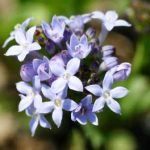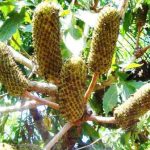TREE LIFE
September 2006
MASHONALAND CALENDAR
Saturday 2nd September: Botanic Garden Walk. Tom will be away this month and therefore there will be no walk.
Sunday 17th September: Shenstone, Mt Hampden by kind permission of Jean Simon. We had an interesting visit there in April this year and we hope to find more interest again this time.
Saturday 23rd: September Mark will be away and therefore this walk is cancelled.
Tuesday 3rd October: Tom will still be away at this date and therefore the walk is cancelled.
MATABELELAND CALENDAR
Please contact Jean Wiley or Gill Short for details of the next Matabeleland function.
EWANRIGG: 20 AUGUST 2006
In the last few years, we have been fairly regular visitors to Ewanrigg Botanical Garden. So what is of interest? The area consists of low rocky hills dissected by small valleys. There are many areas of cultivated flower beds, many containing the species of aloe for which the Garden is well known, and these are interspersed with some areas of remaining native woodland. The altitude is a bit lower than Harare, about 1300 m (4300 feet) although the trees are generally similar.
13 members and guests assembled in a far car park and we split into two groups. Meg Coates Palgrave kindly offered to take a beginners’ group and I led a more advanced group
The cars were parked in msasa / munondo woodland and in the understorey were some species of interest. Firstly, the often striking Vernonia myriantha (Eared vernonia). This has clusters of pale purplish flowers arranged in wide flat-topped heads. In full flower it is a beautiful species although often it does look rather a scruffy species in the wild. As far as I know, it is never found in cultivation.
The ‘Eared’ part of the name refers to the very prominent ear-like false stipules which arise at the bottom of the leaf stalks. Although very noticeable early in the season they fall off and disappear around flowering time giving the tree a quite different appearance.
One of the interesting, although often rather confusing things about places like Ewanrigg, is that it is a mixture of planted and wild species, so that one never knows whether a plant is native or not. It considerably widens the options and makes identification more complex.
One example of this occurred straight away. On one of the trees near the cars was the Leopard orchid, Ansellia africana. This frequently turns up around Harare, e.g. in the Mukuvisi Woodland, and often one suspects that it is planted.
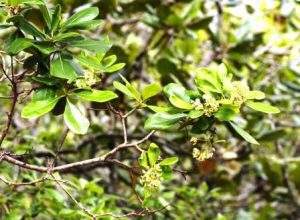
Pittosporum viridiflorum. Photo: Bart Wursten. Source: Flora of Zimbabwe
Another common species was the Cheesewood, Pittosporum viridiflorum. This is very often found around Harare as an evergreen shrub in the understorey of woodland. The fruit is a yellow capsule containing orange sticky seeds.
Near the car park was a planted Tamarind, Tamarindus indica.
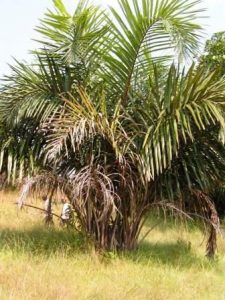
Raphia farinifera. Photo: Jos Stevens. Source: Flora of Zimbabwe
Also there was a planted Raffia palm, Raphia farinifera. This is famous for its extremely long leaves, said to be the longest of any species in the world. These fine planted specimens were bearing the huge pinnate leaves and also the striking glossy dark brown fruits.
Worldwide this species occurs in E Africa and extends southwards to Zimbabwe and Mozambique; it also occurs in Madagascar. In Zimbabwe, these palms occur naturally in the ‘Palm block’ area of the northern Dyke and also occur in the eastern districts. Coates Palgrave suggests that these rather isolated colonies are relic populations from a once much wider population.
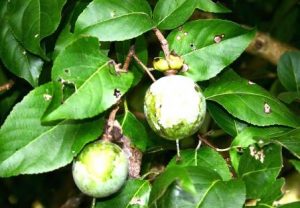
Oncoba spinosa. Photo: Bart Wursten. Source: Flora of Zimbabwe
Also planted was another native species, Oncoba spinosa (Fried egg flower). Generally a species of lower altitude riverine vegetation, but there are records from higher altitudes and the species certainly does well in gardens around Harare. As we have seen at Val D’Or at an altitude of 1530 m. This tree was bearing the typical spherical fruits; these have an apical disk-shaped stigma borne on a short stalk.
A short walk brought us to the herb garden. Few of these species have relevance to the Tree Society as they are firstly mostly herbaceous and secondly exotic species to us. Nevertheless it was still of interest to walk around the circular lay-out and where possible draw comparisons with our native species.
The next stage of the walk took us through more miombo woodland. Here were a number of small trees of the Pink jacaranda (Stereospermum kunthianum). Often thought of as a low and medium-altitude species, it is fairly frequently seen in the rocky hills around Harare, sometimes attaining surprisingly high altitudes. The leaves are opposite and 1-pinnate. The bark is distinctive with pale peeling patches. None of these trees was large enough to bear flowers.
Also in the woodland were some apparently escaped specimens of a Cactus, maybe the Queen of the Night. Again this sort of escape is characteristic of a place such as Ewanrigg.
We emerged amongst the more formal flower beds and puzzled over some of the cultivated trees and plants. Cultivated trees are an area which the Tree Society could perhaps get to know a bit better.
Lunch followed and afterwards, everyone departed for home. All in all it was an interesting day. The Society’s very grateful thanks go to Meg for leading the beginners’ group.
-Mark Hyde
WHY ARE MISTLETOE LEAVES COLD?
On a recent tip to Mazvikadei it was noted that the mistletoe leaves were colder than ambient temperature, and this peculiar behavior has been noted on subsequent outings. Why are mistletoe leaves cold? Here are some thoughts and observations on this subject.
When in 1976, we moved to our farm in Shurugwi, near Gweru, we planted a pecan (Carya illinoensis) orchard. After about 12 to 15 years, mistletoe (unknown, probably Tapinanthus sp) threatened to become a serious problem, so we began a program of mistletoe eradication. We found that even small mistletoes had roots which extended up to 1 to 2 meters into the host branches. These roots, red in colour, grew between the cambium and the xylem, allowed the xylem to grow around them, so that when the roots were removed the root pattern was seen to be embedded into the xylem. In this position, the mistletoe root was able to draw water from the xylem.
Google searches of the web led to many mistletoe references to cold leaves, and high transpiration rates, but no direct explanations were found as to why this should happen.
Mistletoes are obligate hemiparasites. They can not exist separate from their hosts, and they get all of their moisture, and some, 10% to 60%, in some cases 100%, of their carbon from their hosts. To do this they must draw water from the host xylem and they must at all times maintain a lower pressure within its root system, than in the host environment surrounding the mistletoe root. If it does not do this the host would drain it of its moisture and the parasite would quickly die. To understand how this is done it is necessary to understand how tree plumbing works.
Imagine a tree 80 meters tall. It gets its moisture to the topmost leaves as follows:-
Root pressure can generate pressures up to a maximum of about 6m. This is done by osmosis, whereby relatively dilute solutions in the soil, try to lower the sap concentrations within the root, via the root surface, which is a semi-permeable membrane, thus forcing water into the roots.
Transpiration pull is the main agent for lifting water. Connecting the root zone to the leaf zone are a series of xylem cells forming a system of capillary sized tubes transporting water up to the leaves. Within the leaves, these tubes are connected to the leaf stomata. Here a meniscus is formed. It is this meniscus at the top of the cell column connected to the roots that generates the power to lift. The tree’s power to lift water depends upon the shape and surface tension of this meniscus. The shape of the meniscus is controlled by the leaf design, and the transpiration rate. A high rate of transpiration results in a high transpiration pull.
The “root” of a mistletoe is called an haustorium. Unlike the root of a tree which takes up water by osmosis, the haustorium has special cells which penetrate the host xylem cells and gain access to the host’s water within the host xylem cells. To drive the water, with its constituent mineral salts, into the haustorium requires transpiration pull from the leaves. The stomata in mistletoe leaves are permanently open to allow this constant need for transpiration. It is this constant transpiration, needed to suck water from host to mistletoe, which causes the leaves to be relatively cold.
-Bernard Beekes
YELLOW AESCHYNOMENE AT GREYSTONE PARK
Those who attended the walk at Greystone Park on 22nd July 2006 will remember the semi-floating aquatic plant with yellow flowers borne on long stems.
At the time we thought it was a species of Aeschynomene and later work on the specimen which we fished out, confirmed this.
It was in fact Aeschynomene fluitans, a species native to southern tropical Africa and just reaching the north of Zimbabwe.
Although the species could have spread here as a native plant, I suspect that it is more likely to be a cultivated aquatic which has escaped into the Greystone Park Dam.
Perhaps this is the start of frequent occurrences of this very distinctive species around Harare?
-Mark Hyde
BOTANIC GARDEN WALK 5 AUGUST 2006
Tom’s subjects for the day were the families Ulmaceae and Sapindaceae. The latter we only just started and I’ll leave the write-up for a later Tree Life.
The Ulmaceae is a small family in Zimbabwe with only 3 genera: Celtis, Chaetachme and Trema.
The main features are:
• always woody;
• stipules present;
• sometimes spiny (Chaetachme);
• leaves alternate, simple;
• leaves 3-veined from the base;
• monoecious or dioecious;
• sepals present but no petals;
• flowers usually unisexual (less often bisexual);
• ovary superior.
Of the three genera, Tom has no specimens of Trema in the garden – none have survived!
Chaetachme has one species in Zimbabwe, C. aristata. This is the only spiny Ulmaceae in Zimbabwe. The leaves are held in one plane and are exceptionally glossy. It is a true forest edge species and seems to be quite local. It grows, for example, at Murahwa’s Hill near Mutare.
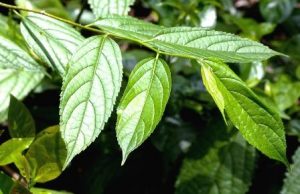
Celtis gomphophylla. Photo: Bart Wursten. Source: Flora of Zimbabwe
The genus Celtis has three species in Zimbabwe.
The first we looked at was Celtis gomphophylla, the Rough-leaved white stinkwood.
This is a large (to 40 m) rain forest species and is unusual among rain forest species in being deciduous. The lower trunk is basically grey in colour and covered in lenticels and has enormous buttress roots. The slash has pink speckled flecks.
Perhaps the most remarkable feature of this species is that it has roots which stink like bad toilets. In Zimbabwe it occurs only in the E division.
Celtis mildbraedii, the Red-fruit white stinkwood is another Eastern districts species, occurring in Zimbabwe only in the Chirinda Forest. This is a ‘second storey’ tree in the understorey of evergreen forests i.e. almost reaching the canopy. Tom called it ‘the rain forest brother of C. africana. Unlike the other two species it is totally evergreen. Near Dombe, Mozambique, however, it is a huge canopy tree. The slash is not speckled but has maroon bands.
The final celtis is Celtis africana, the White stinkwood, a frequent and widespread species in Zimbabwe. occurring in riverine forest and on rocky outcrops. Like the others the leaves are 3-veined from the base; they are also toothed only in the upper part (a convenient character which distinguishes it from Trema).
Once again, our thanks go to Tom for giving up his time for the Tree Society.
-Mark Hyde
MARK HYDE CHAIRMAN


